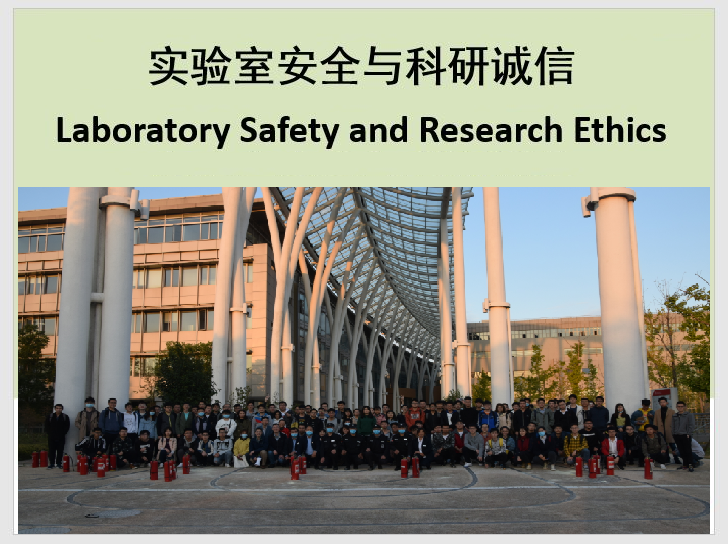
Being prepared for danger in times of peace, thinking is prepared, prepared means less fear, on November 3 and 5, 120 graduate students in each of the two classes of Laboratory Safety and Scientific Research Integrity of the School of Physical Science and Technology (SPST) conducted a fire drill under the guidance of the teacher and teaching assistant team. All students evacuate from the large classroom in order to the west end of the interactive corridor within five minutes with the number of head count. The focus of the exercise was fire emergency response. According to the principle of 1theory to 3 know-how, the sub-groups successively practiced the use of dry powder fire extinguishers, fire blankets and handling chemical leaks, and conducted a group of real fire extinguishing competition. The event was organized in timely manner according to local conditions. The students were enthusiastic, actively practiced and carried out adequate emergency exercises. Xu Xuguang, assistant dean of the SPST, and Wang Dongming, director of the EHS Office came to the site to encourage safety study and practice, and guide drills. The Office of General Services provided fire-fighting equipment, and the facility management team provided assistance throughout the process.
Emergency Evacuation Drill on the course of Laboratory Safety and Scientific Research Integrity
Xu Xuguang,Deputy Dean of SPST
Wang Dongming, Director of the Office of EHS
This emergency evacuation drill is the final practical part of the compulsory course Laboratory Safety and Scientific Research Integrity newly offered by SPST this year for the first-year graduate students of the school. This course aims to cultivate students' safety awareness, analyze and deal with potential hazards, master the ability to avoid danger in emergency, and improve the awareness of scientific research integrity, so as to form a safety belt for freshmen who are about to enter the laboratory to start scientific research. The first eight-week course was attended by 240 students from the SPST internally and 13 joint institutes, and received positive feedback after class.
The teaching of Laboratory Safety and Scientific Research Integrity course has been highly valued and strongly supported by university and schools. Under the proposal and overall arrangement of Office of the Academic Affairs and the safety committee of the school, a team of teachers led by researcher Liu Haiming from the Analysis and Testing Center of the SPST, including Professor Li Jun and Professor Liu Weimin of the SPST, Liu Yanfei from the teaching laboratory of chemistry, and Lu Shuangling, the safety manager of SPST, Li Ruiqing, the deputy director of the EHS Office, carried out planning and designing of the curriculum and teaching plan, and received guidance from the SPST's Environmental Health and Safety Committee. The inter-departmental and cross-functional teaching team adopts the concept of learning, asking, thinking, differentiating, and committed to systematically teach laboratory safety and scientific research integrity from theory to practice.
Learning from traditional safety education courses, the Laboratory Safety and Scientific Research Integrity course features a theoretical system, enhanced understanding, emphasis on practice, and diverse formats. In view of the different characteristics of physics, chemistry and biology laboratories, this course teaches chemical safety and protection, spill response, common physical hazards and protection, biological lab safety, and environment and health in different categories. In addition to a comprehensive overview and detailed explanation of the safety knowledge system, the Four No Harm principle and the Respect Safety throughout the course, the course is arranged with a wealth of video teaching, in-class tests, in-depth case study and fire drills . Strengthen awareness and talk about methods in class, and emphasize practice after class. One of the course assignments is to allow students to conduct safety inspections in their respective laboratories, field trips to identify under-standard corners, and conduct risk analysis and rectification of hidden dangers based on theoretical knowledge. Through personal practices, students digest and keep in mind what they have learned in class, and truly achieve always reiterate safety requirements, always practice Standard Operating Procedures. While practicing and consolidating safety knowledge, students also continuously strengthen their willingness to safety, raise safety awareness, and help improve laboratory safety. In addition, this course also explains the importance of scientific research integrity and academic standards to help new graduate students establish a good concept of integrity.
Through the offering of a new course and new practice of Laboratory Safety and Scientific Research Integrity, the SPST not only allows students to systematically learn laboratory safety knowledge and skills, exercise their ability to distinguish and respond to emergencies, but also strengthen their safety willingness and awareness , which guides a good value of scientific research integrity, is conducive to improving the overall safety of laboratories and campuses, and assists in promoting the cultivation of campus safety culture. This course has been strongly supported by the SPST's Environmental Health and Safety Committee. Everyone should pay attention to safety, and one who does not may be at risk. In the future, SPST will continue to improve the curriculum of Laboratory Safety and Scientific Research Integrity, deepen the cultivation of students' safety awareness, and establish and promote the core concept of university’s characteristics in accordance with ShanghaiTech University's small-scale, high-level, international orientation, cultivating the safety culture, the integration of theory and practice, continuously improving the safety education and management level of the University.


